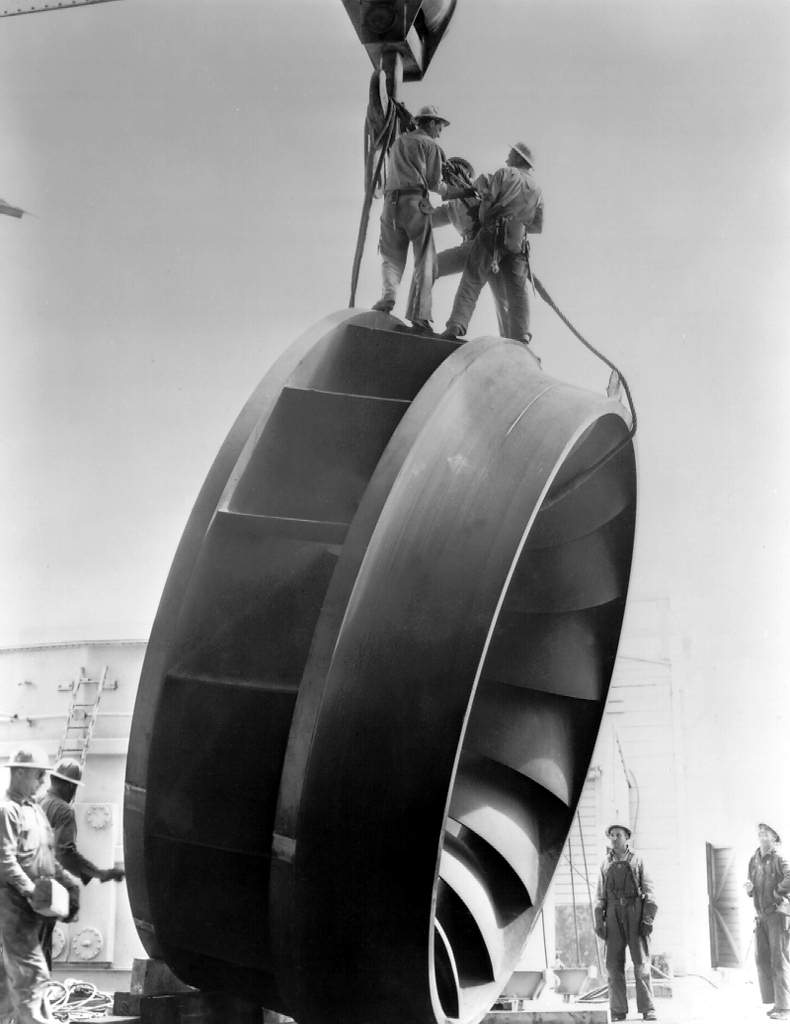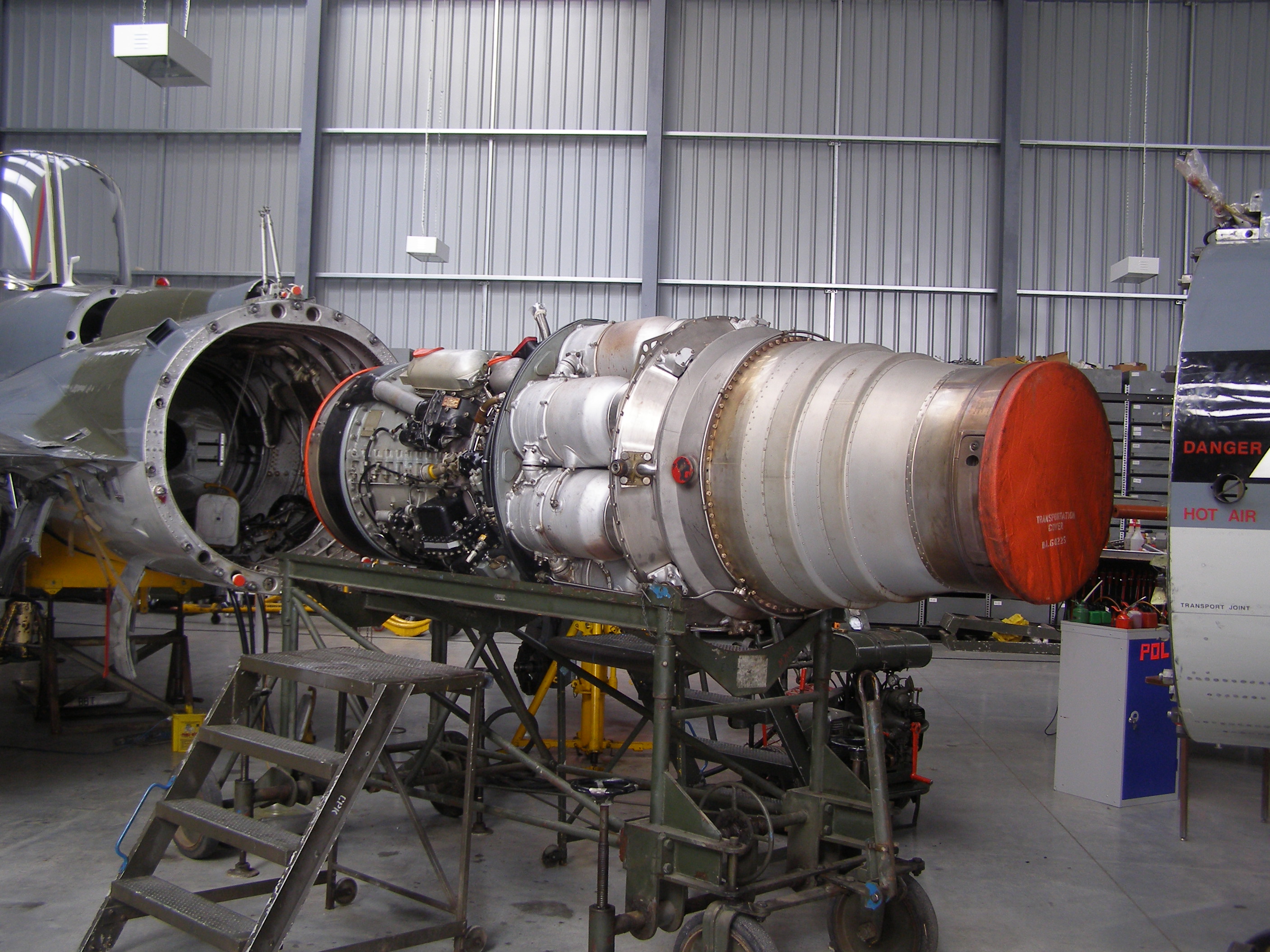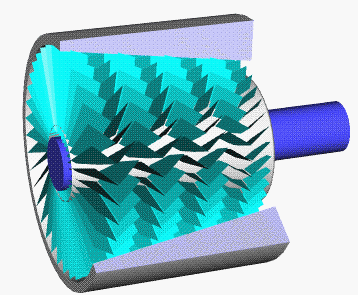|
Rolls-Royce Nene 4
The Rolls-Royce RB.41 Nene is a 1940s British centrifugal compressor turbojet engine. The Nene was a complete redesign, rather than a scaled-up Rolls-Royce Derwent"Rolls-Royce Aero Engines" Bill Gunston, Patrick Stephens Limited 1989, , p.111 with a design target of , making it the most powerful engine of its era. It was Rolls-Royce's third jet engine to enter production, and first ran less than 6 months from the start of design. It was named after the River Nene in keeping with the company's tradition of naming its jet engines after rivers. The design saw relatively little use in British aircraft designs, being passed over in favour of the axial-flow Avon that followed it. Its only widespread use in the UK was in the Hawker Sea Hawk and the Supermarine Attacker. In the US it was built under licence as the Pratt & Whitney J42, and it powered the Grumman F9F Panther. Its most widespread use was in the form of the Klimov VK-1, a reverse-engineered, modified and enlarged ... [...More Info...] [...Related Items...] OR: [Wikipedia] [Google] [Baidu] |
WikiProject Aircraft
A WikiProject, or Wikiproject, is a Wikimedia movement affinity group for contributors with shared goals. WikiProjects are prevalent within the largest wiki, Wikipedia, and exist to varying degrees within sister projects such as Wiktionary, Wikiquote, Wikidata, and Wikisource. They also exist in different languages, and translation of articles is a form of their collaboration. During the COVID-19 pandemic, CBS News noted the role of Wikipedia's WikiProject Medicine in maintaining the accuracy of articles related to the disease. Another WikiProject that has drawn attention is WikiProject Women Scientists, which was profiled by '' Smithsonian'' for its efforts to improve coverage of women scientists which the profile noted had "helped increase the number of female scientists on Wikipedia from around 1,600 to over 5,000". On Wikipedia Some Wikipedia WikiProjects are substantial enough to engage in cooperative activities with outside organizations relevant to the field at issue. For e ... [...More Info...] [...Related Items...] OR: [Wikipedia] [Google] [Baidu] |
Centrifugal Compressor
Centrifugal compressors, sometimes called impeller compressors or radial compressors, are a sub-class of dynamic axisymmetric work-absorbing turbomachinery. They achieve pressure rise by adding energy to the continuous flow of fluid through the rotor/impeller. The following equation shows this specific energy input. A substantial portion of this energy is kinetic which is converted to increased potential energy/static pressure by slowing the flow through a diffuser. The static pressure rise in the impeller may roughly equal the rise in the diffuser. Equation-0.1 : H = \left( \left( R \right)_2 - \left( R \right)_1 \right) :where the control volume nomenclature (illustrated in Figure-0.4) is: ::* subscript, is the impeller inlet location, station1 ::* subscript, is the impeller discharge/exit location, station2 ::* is the energy input per unit mass, units=(LP/m) ::* is the impeller's rotation speed, units=(radians/t) ::* is the radius of specified location, units=(L) ::* is ve ... [...More Info...] [...Related Items...] OR: [Wikipedia] [Google] [Baidu] |
Lucas Industries
Lucas Industries plc was a Birmingham-based British manufacturer of motor industry and aerospace industry components. Once prominent, it was listed on the London Stock Exchange and was formerly a constituent of the FTSE 100 Index. In August 1996, Lucas merged with the American Varity Corporation to form LucasVarity. After LucasVarity was sold to TRW the Lucas brand name was licensed for its brand equity to Elta Lighting for aftermarket auto parts in the United Kingdom. The Lucas trademark is currently owned by ZF Friedrichshafen, which retained the Elta arrangement. History Foundation In the 1850s, Joseph Lucas, a jobless father of six, sold paraffin oil from a barrow cart around the streets of Hockley. In 1860, he founded the firm that would become Lucas Industries. His 17-year-old son Harry joined the firm around 1872. [...More Info...] [...Related Items...] OR: [Wikipedia] [Google] [Baidu] |
Combustion Chamber
A combustion chamber is part of an internal combustion engine in which the fuel/air mix is burned. For steam engines, the term has also been used for an extension of the firebox which is used to allow a more complete combustion process. Internal combustion engines In an internal combustion engine, the pressure caused by the burning air/fuel mixture applies direct force to part of the engine (e.g. for a piston engine, the force is applied to the top of the piston), which converts the gas pressure into mechanical energy (often in the form of a rotating output shaft). This contrasts an external combustion engine, where the combustion takes place in a separate part of the engine to where the gas pressure is converted into mechanical energy. Spark-ignition engines In spark ignition engines, such as petrol (gasoline) engines, the combustion chamber is usually located in the cylinder head. The engines are often designed such that the bottom of combustion chamber is roughly in li ... [...More Info...] [...Related Items...] OR: [Wikipedia] [Google] [Baidu] |
Impeller
An impeller or impellor is a rotor used to increase the pressure and flow of a fluid. It is the opposite of a turbine, which extracts energy from, and reduces the pressure of, a flowing fluid. In pumps An impeller is a rotating component of a centrifugal pump that accelerates fluid outward from the center of rotation, thus transferring energy from the motor that drives the pump to the fluid being pumped. The velocity achieved by the impeller transfers into pressure when the outward movement of the fluid is confined by the pump casing. An impeller is usually a short cylinder with an open inlet (called an eye) to accept incoming fluid, vanes to push the fluid radially, and a splined, keyed, or threaded bore to accept a drive shaft. It can be cheaper to cast an impeller and its spindle as one piece, rather than separately. This combination is sometimes referred to simply as the "rotor." Types Open impellers An open impeller has a hub with attached vanes and is mounted ... [...More Info...] [...Related Items...] OR: [Wikipedia] [Google] [Baidu] |
GE Aviation
GE Aviation, a subsidiary of General Electric, is headquartered in Evendale, Ohio, outside Cincinnati. GE Aviation is among the top aircraft engine suppliers, and offers engines for the majority of commercial aircraft. GE Aviation is part of the General Electric conglomerate, which is one of the world's largest corporations. The division operated under the name of General Electric Aircraft Engines (GEAE) until September 2005. GE Aviation's main competitors in the engine market are Pratt & Whitney and Rolls-Royce. Not only does GE Aviation manufacture engines under its own umbrella, it also partners with other manufacturers. CFM International, the world’s leading supplier of aircraft engines and GE’s most successful partnership, is a 50/50 joint venture with the French company Safran Aircraft Engines. As of 2019, CFM International holds 39% of the world's commercial aircraft engine market share (while GE Aviation itself holds a further 16%). GE and Safran also operate anot ... [...More Info...] [...Related Items...] OR: [Wikipedia] [Google] [Baidu] |
Pulqui Engine
The Pulqui (from indigenous language Mapudungun, ''Pulqúi'': Arrow) was a series of jet prototypes developed by Argentina Argentina (), officially the Argentine Republic ( es, link=no, República Argentina), is a country in the southern half of South America. Argentina covers an area of , making it the second-largest country in South America after Brazil, th ... after World War II. They were the first jet aircraft developed in Latin America. * I.Ae. 27 Pulqui I (1947) * FMA IAe 33 Pulqui II (1950) * El Pulqui (Empresa) (1963) {{Dab ... [...More Info...] [...Related Items...] OR: [Wikipedia] [Google] [Baidu] |
Mikoyan-Gurevich MiG-15
The Mikoyan-Gurevich MiG-15 (russian: Микоя́н и Гуре́вич МиГ-15; USAF/DoD designation: Type 14; NATO reporting name: Fagot) is a jet fighter aircraft developed by Mikoyan-Gurevich for the Soviet Union. The MiG-15 was one of the first successful jet fighters to incorporate swept wings to achieve high transonic speeds. In aerial combat during the Korean War, it outclassed straight-winged jet day fighters, which were largely relegated to ground-attack roles. In response to the MiG-15’s appearance and in order to counter it, the United States Air Force rushed the North American F-86 Sabre to Korea.Thompson, Warren"Sabre: The F-86 in Korea."''Flight Journal'', December 2002. Retrieved: 30 June 2011. When refined into the more advanced MiG-17, the basic design would again surprise the West when it proved effective against supersonic fighters such as the Republic F-105 Thunderchief and McDonnell Douglas F-4 Phantom II in the Vietnam War of the 1960s. The MiG-15 ... [...More Info...] [...Related Items...] OR: [Wikipedia] [Google] [Baidu] |
Reverse Engineering
Reverse engineering (also known as backwards engineering or back engineering) is a process or method through which one attempts to understand through deductive reasoning how a previously made device, process, system, or piece of software accomplishes a task with very little (if any) insight into exactly how it does so. It is essentially the process of opening up or dissecting a system to see how it works, in order to duplicate or enhance it. Depending on the system under consideration and the technologies employed, the knowledge gained during reverse engineering can help with repurposing obsolete objects, doing security analysis, or learning how something works. Although the process is specific to the object on which it is being performed, all reverse engineering processes consist of three basic steps: Information extraction, Modeling, and Review. Information extraction refers to the practice of gathering all relevant information for performing the operation. Modeling refers to th ... [...More Info...] [...Related Items...] OR: [Wikipedia] [Google] [Baidu] |
Supermarine Attacker
The Supermarine Attacker is a British single-seat naval jet fighter designed and produced by aircraft manufacturer Supermarine for the Royal Navy's Fleet Air Arm (FAA). The type has the distinction of being the first jet fighter to enter operational service with the FAA.Bingham 2004, p. 109. In order to rapidly introduce jet aircraft to Navy service, Supermarine proposed adapting their most advanced piston-powered design, the Supermarine Spiteful, with a new fuselage for the Rolls-Royce Nene engine. Performing its maiden flight on 27 July 1946, the flight testing phase of development was protracted due to several issues, including handling difficulties. The first Attackers were introduced to FAA service in August 1951. Common to the majority of other first-generation jet fighters, the Attacker had a relatively short service life before being replaced; this was due to increasingly advanced aircraft harnessing the jet engine being rapidly developed during the 1950s and 1960s. D ... [...More Info...] [...Related Items...] OR: [Wikipedia] [Google] [Baidu] |
Rolls-Royce Avon
The Rolls-Royce Avon was the first axial flow jet engine designed and produced by Rolls-Royce. Introduced in 1950, the engine went on to become one of their most successful post-World War II engine designs. It was used in a wide variety of aircraft, both military and civilian, as well as versions for stationary and maritime power. An English Electric Canberra powered by two Avons made the first un-refuelled non-stop transatlantic flight by a jet, and a BOAC de Havilland Comet 4 powered by four Avons made the first scheduled transatlantic crossing by a jet airliner. Production of the Avon aero engine version ended after 24 years in 1974.Gunston 1989, p. 149. Production of the Avon-derived industrial version, currently produced by Siemens, continues to this day. The current version of the Avon, the Avon 200, is an industrial gas generator that is rated at . As of 2011, 1,200 Industrial Avons have been sold, and the type has established a 60,000,000 hour record for its class. ... [...More Info...] [...Related Items...] OR: [Wikipedia] [Google] [Baidu] |
Axial Flow
An axial compressor is a gas compressor that can continuously pressurize gases. It is a rotating, airfoil-based compressor in which the gas or working fluid principally flows parallel to the axis of rotation, or axially. This differs from other rotating compressors such as centrifugal compressor, axi-centrifugal compressors and mixed-flow compressors where the fluid flow will include a "radial component" through the compressor. The energy level of the fluid increases as it flows through the compressor due to the action of the rotor blades which exert a torque on the fluid. The stationary blades slow the fluid, converting the circumferential component of flow into pressure. Compressors are typically driven by an electric motor or a steam or a gas turbine. Axial flow compressors produce a continuous flow of compressed gas, and have the benefits of high efficiency and large mass flow rate, particularly in relation to their size and cross-section. They do, however, require seve ... [...More Info...] [...Related Items...] OR: [Wikipedia] [Google] [Baidu] |








